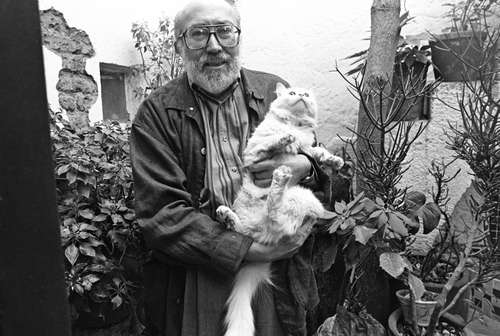On May 22, 100 years of the birth of Emilio Carballido Fontanes (1925-2008), playwright, writer and scriptwriter for Mexican scenic art, with an uninterrupted production of six decades are celebrated. Although his work had its central axis in the theater, he also ventured into children’s literature, cinema and opera. He was also a teacher committed to the formation of new generations and ambassador of Mexican theater on international scale.
Carballido was born in 1925 in Córdoba, Veracruz, and as a child he moved to Mexico City. He studied Law at the National Autonomous University of Mexico (UNAM) until he left the race in the second year to join the Faculty of Philosophy and Letters, where he studied a master’s degree in letters specializing in dramatic art. He was part of the 50th generation, group of students from Rodolfo Usigli at UNAM. Among his companions were Luisa Josefina Hernández, Jorge Ibargüengoitia, Sergio Magaña, Rosario Castellanos, Dolores Castro and Sergio Galindo.
Debuted at age 25 at the Palace of Fine Arts with Rosalba and Los Llaveros (1950), directed by Salvador Novo. In a context where Mexican dramaturgy was dominated by melodrama and Spanish living room pieces, its proposal represented a new way of understanding theater and seeing Mexican reality.
That presentation was a historical fact, because it marked a before and after in Mexican dramaturgy
said researcher Luis Mario Moncada, National Theater Coordinator of the National Institute of Fine Arts and Literature.
Throughout his career he wrote more than 200 plays, almost all mounted. Among his outstanding titles are A small day of anger (1961), Silence, chickens, they are going to throw their corn! (1963), I swear, Juana, I want (1965), I also talk about the rose (1965), Acapulco on Mondays (1969), Mozart’s letters (1974) y Two aromas rose (1986).
Its production also included 50 film scripts and three operas: Chinese foxes, waiting room y Mass of 6, In addition to 15 children’s stories published by the Economic Culture Fund (FCE) and Children’s Theater edited by Porrúa.
In a period in which intellectuals occupied diplomatic positions, such as Carlos Fuentes, in France; Octavio Paz, in India; Or Sergio Pitol, in Prague, Carballido rejected these offers. He didn’t want to say that office work and cocktails would take time to write
his life partner Héctor Herrera told.
Carballido also promoted the diffusion of the theater in Mexico. In 1975 he founded the magazine Tramoya, published by the Veracruz University (UV). This is the second oldest theater publication in Latin America and the third in Spanish, surpassed only by Set (Cuba) and First act (España).
“It cost him work to publish his theater; The publishers told him that they edited novels and poetry, but not theater, so he promoted from the UV the edition of Tramoya, And he began to give space to authors not only of the capital of the country, but from the interior of the Republic, ”added Herrera.
In addition to his prolific work as playwright, Carballido left a deep teacher’s mark. Felio Eliel, Cordoba header actor for more than five decades, said that each work was a learning. I was fortunate that I was my text analysis teacher, because there are the important elements to make a characterization and to live a character. The way Emilio explained how to undertake a dramatic text was key in my actor formation
.
Carballido caused Mexican theater to transcend borders, not only through his works, which were represented and recognized in several countries, but because it promoted other authors.
The Veracruz playwright Francisco Beverido recalled that they once called the creator Víctor Hugo Rascón Banda to present a work of his in Peru. When he asked how they found out about that piece, it turned out that Emilio had been there
.
In 1961 he wrote A small day of angerwhere he portrayed political repression in Mexico, since he felt a commitment to social causes, which was also reflected in 1968, sympathizing with the student movement.
In March 2007, Carballido formalized its union with Herrera under the Law on Coexistence Societies in Mexico City, the same day that it was released.
It was our desire to express our support for the struggle of same -sex couples in Mexico
said Herrera, who also remembers the obstacles they faced when Carballido was admitted to a hospital.
“I could not comment, authorize or make decisions about Emilio’s treatments, until one day I got very angry, and I told them: ‘How can I not authorize, but when I come to pay they receive the money?’ ”
The author of Two aromas rose He died in 2008; left 10 accounting notebooks lined with leather with the phrase There must be
where he wrote most of his works, in addition to 100 notebooks with personal newspapers and notes, who are under family protection. Despite the changes in the current dramaturgy, its legacy is still alive in the Mexican theatrical scene, where his work continues to assemble and study, which reaffirms his place as an essential figure of national scenic art.

Can Geo Photoclub
paizo.com – Paizo People: JimenadfRubio
Quomon.es
Karley D's Profile | RV Parking
LuciandfLamb's SMITEFire Profile: SMITE Community Profile
Stephen Wiley – Profile
Jaydin Castro's (SimeondfAyers) software portfolio | Devpost
Artists Directory | Doodle Addicts
ChillSpot1 – KaseydfCalderon's Channel
Ronald Bernard – CakesDecor
JasedfHale's Profle – CFGFactory
Member Profile: Noelle Erickson | VintageMachinery.org
DeandredfStafford on Doodle or Die
Traveler JaylahdfRiddle
Logopond – Logo, Brand & Identity Inspiration
YouCam Community
MarquisdfStevenson – Sketchfab
DeandredfStafford is on akaqa.com – also known as questions & answers.
HaleydfWare
AllydfLopez | Songtree artist profile
Run.GPS Community Server – JourneydfMercer's Athlete Homepage
AdriendfBarrera (AdriendfBarrera) on Animatron
Bayz 102 Danube Project – lino
Chu Mckenzie on Iconfinder
pinterest.com/gasgrease2/
hub.docker.com/u/beaverindex3/
500px
Issabel
Mixcloud
Randolph Borg (frontcloudy7) on Myspace